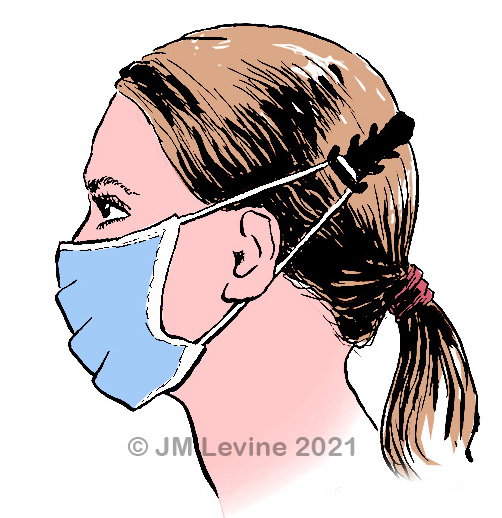
This is an “ear-saver” device which relieves pressure from the posterior ear and assists in preventing pressure injury to this sensitive area.
My recent article in the June issue of Advances in Skin and Wound Care reviews the problem of pressure injury to the ear related to masks. In the article I present a case report of a wound behind the ear of a long-term care resident who sustained a pressure injury to his ear from a mask. Using this case as a springboard, the paper reviews anatomy of the ear, CDC regulations regarding PPE for nursing homes, staging and documentation of pressure injuries to the ear, prevention of mask related pressure injury, and treatment approaches.
Medical device-related pressure injuries (MDRPRI) result from use of medical devices and equipment that are in direct contact with skin and cause external mechanical load leading to soft tissue damage. MDRPI have been well documented in all clinical settings and commonly occur from tubing, continuous positive airway pressure devices (CPAP), physical restraints, cervical collars, and any other object that comes into constant contact with skin. MDRPRI are especially common in vulnerable populations such as neonates and infants, chronically ill persons in post-acute care settings and, critically ill patients in ICU’s.
The ear is a convenient anchor for a mask, which renders it subject to constant pressure and friction from the elastic. Diagnosis of injuries in the postauricular area may be missed or delayed because it is hidden behind the ear and/or covered with hair. Pressure injury to the ear can result in pain, infection, scarring, or permanent deformity.
MDRPRI prevention recommendations adapted for face masks are as follows (modified from the NPIAP/EPIAP Clinical Practice Guideline):
- Consider all patients with masks to be at risk for breakdown behind the ear;
- Using the finger to test tension, make sure the mask is not too tight around the ear;
- Inspect the skin surrounding and under the mask at least twice per day, or more if the patient is at high risk for skin breakdown;
- Apply the mask only when necessary, and remove mask as soon as medically possible;
- For residents of Medicare certified skilled nursing facilities, application of face mask in conjunction with a plan for avoidance of skin breakdown should be part of the care plan.
- Consider using an “ear saver” mask strap to completely avoid pressure and friction to the postauricular area.
There is some evidence that dressings applied beneath medical devices can serve a role in preventing MDRPRI. This however does not alleviate the responsibility to identify high risk persons, perform frequent skin inspections, and check if the mask is too tight.
* * * * * * * * * * * * * * *
Citation for this article is as follows:
Levine JM, Ayello EA, Persaud B, Spinner R. Medical Device-Related Pressure Injury to the Ear from a Mask. Advances in Skin and Wound Care 2021; 34: 380-383.
To access the article please click this link.
Related posts:
Is There a COVID-Related Wound?
Is the Pressure Injury Staging System Obsolete?
New Review on Aging Skin, with Considerations for Clinicians
Determining the Avoidability of Pressure Ulcers
Pressure Injuries and the Human Warranty

We have used the ear savers developed for use on O2 tubing on mask elastic for Pts and staff.